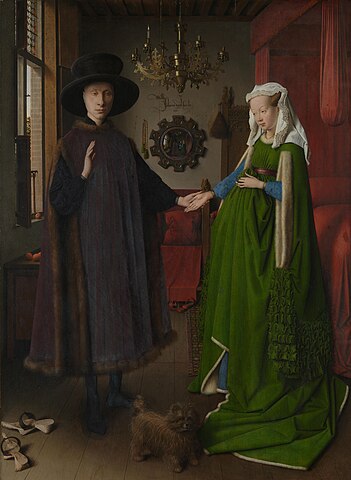Table of Contents
The First Dutch Painter: Who was Jan van Eyck?
Who was Jan van Eyck? The history of Dutch art is renowned for its golden age in the 17th century, marked by the works of iconic artists such as Rembrandt, Vermeer, and Frans Hals. However, the roots of Dutch painting extend much further into the medieval period, with the first recorded Dutch painters emerging from the Low Countries (which include modern-day Belgium and the Netherlands) in the 14th and 15th centuries.
While the definition of “the first Dutch painter” is difficult to pin down due to the fluidity of national borders and the gradual development of art in the region, one figure often regarded as a pioneering artist in Dutch art history is Jan van Eyck (c. 1390 – 1441), whose works had a profound influence on early Netherlandish painting.

By Jan van Eyck – Web site of National Gallery, London, Public Domain, Photo By commons.wikimedia.org
Jan van Eyck and the Dawn of Northern Renaissance
Though some early artists existed before him, Jan van Eyck is frequently hailed as one of the most significant and influential figures in the transition from medieval to early modern art in Northern Europe. Born in the county of Loon, in the Holy Roman Empire (now part of Belgium), Van Eyck’s career flourished in the early 15th century, and his legacy is intricately connected with the rise of Dutch and Flemish painting. He worked primarily in Bruges and Ghent, two cities that played a central role in the burgeoning artistic scene of the Low Countries.
Jan van Eyck is best known for pioneering the use of oil painting, a medium that allowed for unprecedented realism and subtlety in texture, light, and detail. This technique, often misattributed to him as its inventor, was revolutionized under his hand, contributing to the rise of naturalistic depictions of subjects, from the intricate folds of cloth to the reflection of light on surfaces.
His “Ghent Altarpiece” (1432), created in collaboration with his brother Hubert van Eyck, is a landmark in the history of art, demonstrating the blend of religious symbolism and minute, lifelike detail that would come to define Northern Renaissance painting.
Although Jan van Eyck’s works are often considered Flemish rather than strictly Dutch by modern geographical standards, his influence permeated the entire Low Countries and set the stage for later Dutch artists. His meticulous attention to detail and pioneering use of oil paint laid the foundation for the hyperrealism that would become a hallmark of Dutch painting during the 17th-century Golden Age.
Dutch Medieval Art: Predecessors to Van Eyck
Before Jan van Eyck’s rise to prominence, Dutch painting existed largely in the form of religious manuscripts, frescoes, and panel paintings, heavily influenced by Gothic art and architecture. One important figure who predates Van Eyck is Melchior Broederlam (c. 1350 – 1409), an artist active in the Duchy of Burgundy, which at that time included parts of the Low Countries. Broederlam’s detailed altarpieces and religious works displayed a movement toward greater realism, even within the constraints of medieval Gothic styles.
His use of color and narrative space in pieces like the Altarpiece of the Chartreuse de Champmol (1399) demonstrated a growing interest in depicting the natural world in a way that transcended the stiff, abstract styles of earlier medieval art.
Though Broederlam cannot be regarded as “Dutch” in a modern sense, his works reflect the regional influences that shaped the emergence of Dutch art. His exploration of space, color, and naturalism prefigured the breakthroughs that Van Eyck would later master, illustrating that Dutch and Flemish painting evolved within an interconnected artistic world where borders were porous, and influences were shared across regions.
The Importance of National Identity in Art History
It is important to contextualize the search for the “first Dutch painter” within the complex history of national identity. In the Middle Ages and the early Renaissance, the modern concept of the Netherlands did not exist. The region now known as the Netherlands was part of the larger political entity of the Burgundian Netherlands, later the Habsburg Netherlands. These areas spanned parts of present-day Belgium, Luxembourg, and northern France, making it challenging to assign a national identity to artists from that time.
When discussing “Dutch” painting, historians often refer to the broader category of “Netherlandish” or “Flemish” painting, which encompasses the art produced in the region before the separation of the Northern and Southern Netherlands in the 16th century. This distinction became more pronounced after the Eighty Years’ War (1568–1648), which resulted in the independence of the Dutch Republic (the modern Netherlands) from the Spanish-controlled Southern Netherlands (modern Belgium).
In this sense, while Jan van Eyck may not be considered Dutch in a modern sense, his work belongs to the shared cultural and artistic heritage of the Low Countries. As such, he holds a central place in the development of Dutch art, especially considering the far-reaching influence his style had on later artists in the Dutch Republic.
Conclusion
While the title of the “first Dutch painter” cannot be ascribed to a single individual with absolute certainty due to the fluid borders and shared artistic traditions of the time, Jan van Eyck stands as one of the most pivotal figures in the early development of Dutch and Flemish art. His pioneering use of oil paint, coupled with an unparalleled eye for detail, helped to shape the artistic identity of the Low Countries and laid the groundwork for the extraordinary achievements of the Dutch Golden Age. Van Eyck’s contribution transcends national boundaries, embodying a broader Northern Renaissance movement that transformed the world of art in the 15th century.
However, his influence on Dutch painting is undeniable, making him a crucial figure in any discussion of the origins of Dutch art.


No responses yet